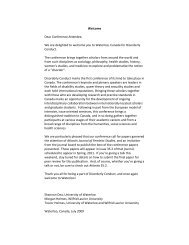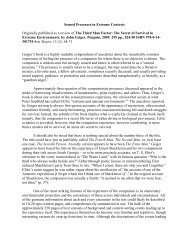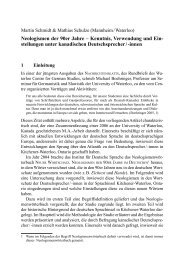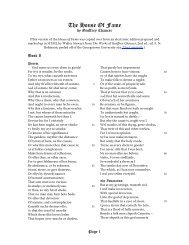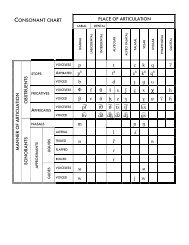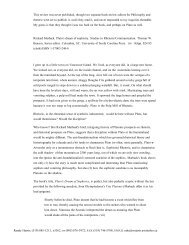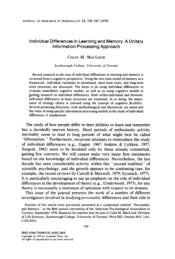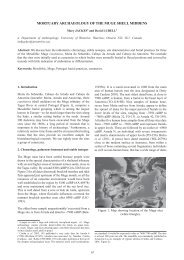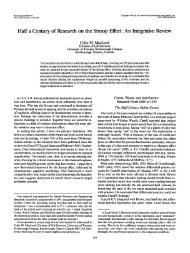The mid seventeenth century collapse of Iroquoian Ontario:
The mid seventeenth century collapse of Iroquoian Ontario:
The mid seventeenth century collapse of Iroquoian Ontario:
You also want an ePaper? Increase the reach of your titles
YUMPU automatically turns print PDFs into web optimized ePapers that Google loves.
the Mid Seventeenth centuRy collapSe <strong>of</strong> iRoquoian on ta R i o<br />
Besides cultural factors, we need to take into account diseases which can cause infertility,<br />
e.g. genital tuberculosis (tuberculosis was well-established in <strong>Ontario</strong> before the 17th <strong>century</strong>;<br />
Pfeiffer, 1984), syphilis (present at Grimsby, Jackes 1988) and smallpox (Rutten, 1993 states<br />
that smallpox did not depress Dutch male fertility, but Saami data contradict this, Sköld,<br />
1997). Beyond the alteration in normal behaviour caused by epidemics <strong>of</strong> infectious disease,<br />
crises induce lowered fertility, not simply from family disruption, delayed marriage and<br />
reduced coital rates. Jowett (1986; 1991) has shown that in China in 1960, infant mortality rose<br />
to nearly 300/1 000 live births, but there was no compensating increase in the birth rate. By<br />
1961, the Chinese national total fertility rate (the average number <strong>of</strong> live-born children a<br />
woman would have if the birth rate <strong>of</strong> that year lasted throughout her reproductive life) fell<br />
to 3.3, almost half what it had been only four years before, partly no doubt due to famine<br />
amenorrhea. In times <strong>of</strong> famine such as in China in 1960-61, not only is there death and a<br />
reduced rate <strong>of</strong> conception, there is a lowered live birth rate. Cai and Feng (2005) demonstrate<br />
that part <strong>of</strong> this depressed fertility comes from an increase in stillbirths, but also from an even<br />
larger increase in miscarriages. <strong>The</strong>re is, <strong>of</strong> course, a normal minimal rate <strong>of</strong> foetal wastage,<br />
perhaps 15% <strong>of</strong> all conceptions (Quenby et al., 2001), but the Chinese data show that famine<br />
will increase that rate markedly. Cai and Feng (2005) provide evidence that social disruption<br />
and stress, in the absence <strong>of</strong> famine, may also reduce fertility rates (even below replacement<br />
level in Shanghai during the Cultural Revolution).<br />
To repeat what was noted above: in 1640-41 the Jesuits estimated 500 fires and 3 000<br />
people in ten Neutral villages (JR, 21, p. 223), an average <strong>of</strong> six people per fire. Since each<br />
hearth was shared by two families, the implication is that Neutral families were very small,<br />
for which low fertility and three years <strong>of</strong> famine, war and disease can be adduced.<br />
Results<br />
<strong>The</strong> under-representation <strong>of</strong> children under 5 years and the inaccuracy <strong>of</strong> adult age estimates<br />
require the use <strong>of</strong> demographic estimators. <strong>The</strong> ratio <strong>of</strong> juveniles aged 5 to 14.99 years<br />
to adults 20 and over (J:A) and the mean <strong>of</strong> the subadult mortality quotients (q 5 , q 10 , q 15 –<br />
Mean Childhood Mortality, MCM) serve as palaeodemographic estimators. From these we<br />
can estimate a total fertility rate for the entire cemetery <strong>of</strong> 11 to 12, the total number <strong>of</strong> liveborn<br />
children the average woman would have over her entire reproductive period (for the<br />
method details and tests <strong>of</strong> the accuracy <strong>of</strong> the method see Jackes, Meiklejohn, 2008).<br />
Figure 4 presents the estimated fertility rates derived from the ratio <strong>of</strong> children to adults,<br />
demonstrating that Huron sites <strong>of</strong> the 16th and 17th centuries suggest a Total Fertility Rate<br />
(TFR) <strong>of</strong> ~4-6 in accord with the ethnohistorical literature (Jackes, 1994). Maurice (Jerkic, 1975)<br />
is dated at around 1640, and its low fertility is what may be expected from increased stress,<br />
reduced food intake, the effects <strong>of</strong> disease and heavy exercise (all the missionaries noted how<br />
hard <strong>Iroquoian</strong> women worked in comparison with the men). Ossossané, as originally<br />
analyzed (Katzenberg, White, 1979; Jackes, 1986) was based on a sample size <strong>of</strong> 249 which<br />
indicated very high fertility in the years prior to 1636. Two further studies <strong>of</strong> Ossossané have<br />
been done in the interim: one with a sample size <strong>of</strong> around 418 (Jimenez, Melbye, 1987) indi-<br />
357



